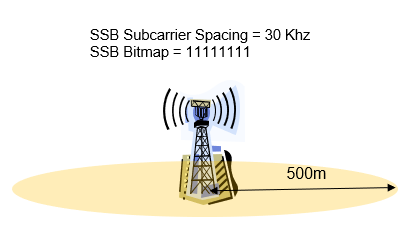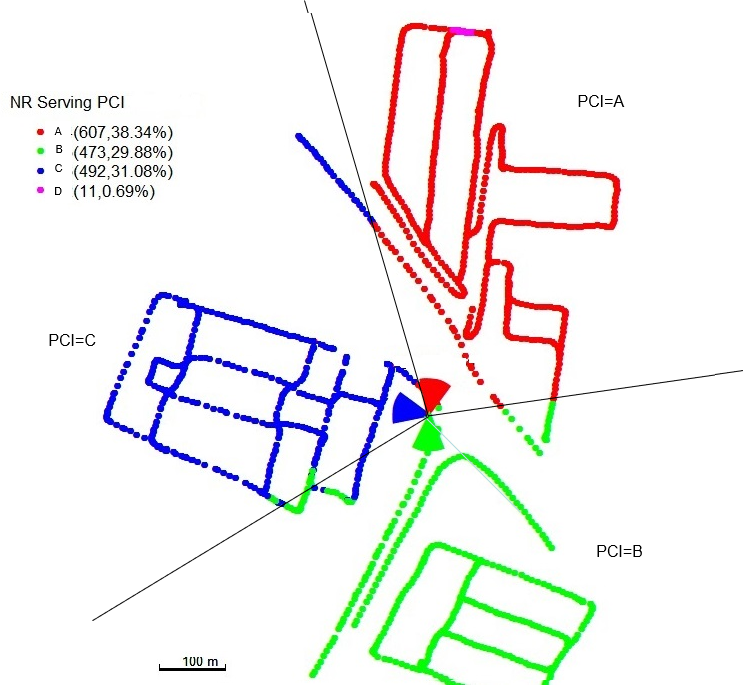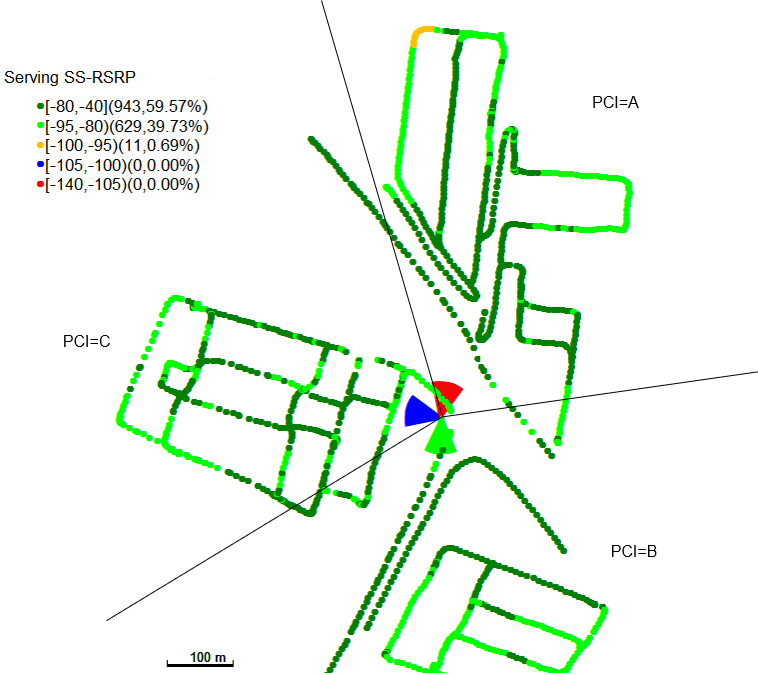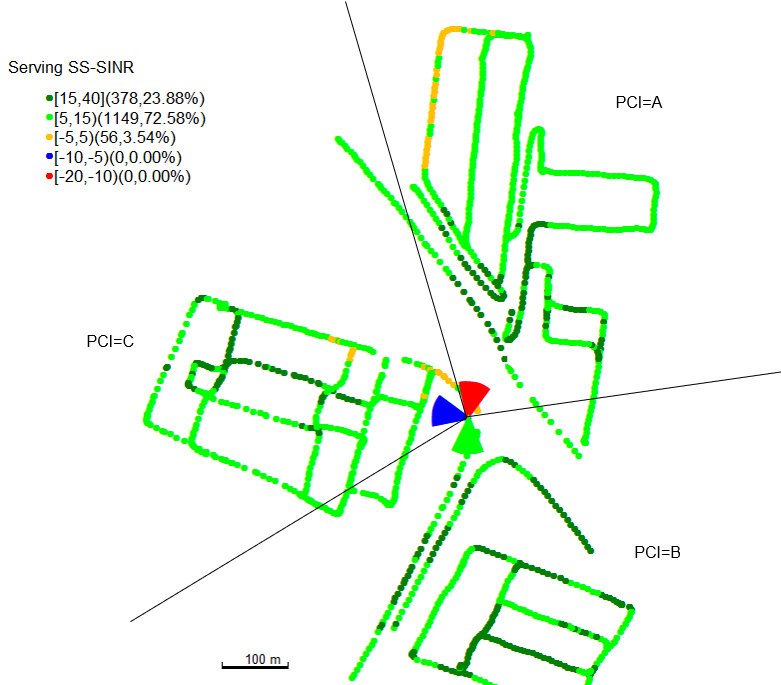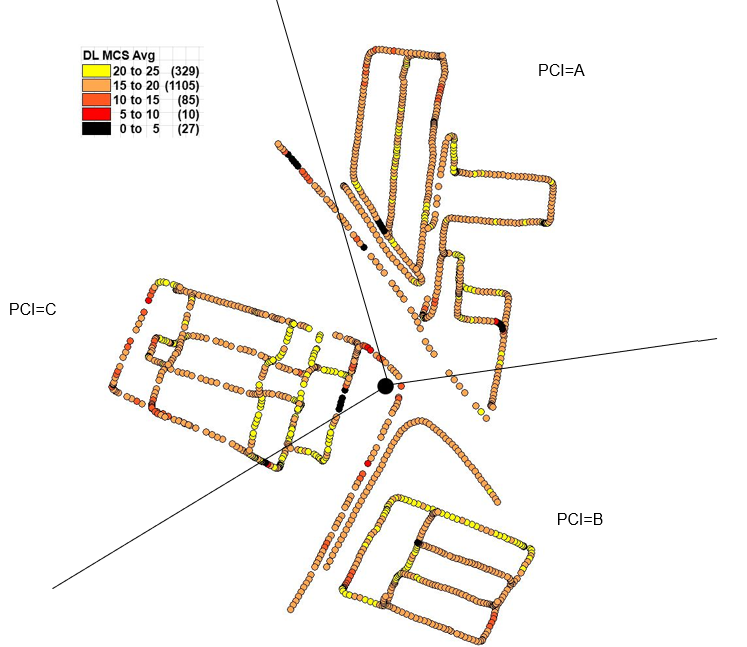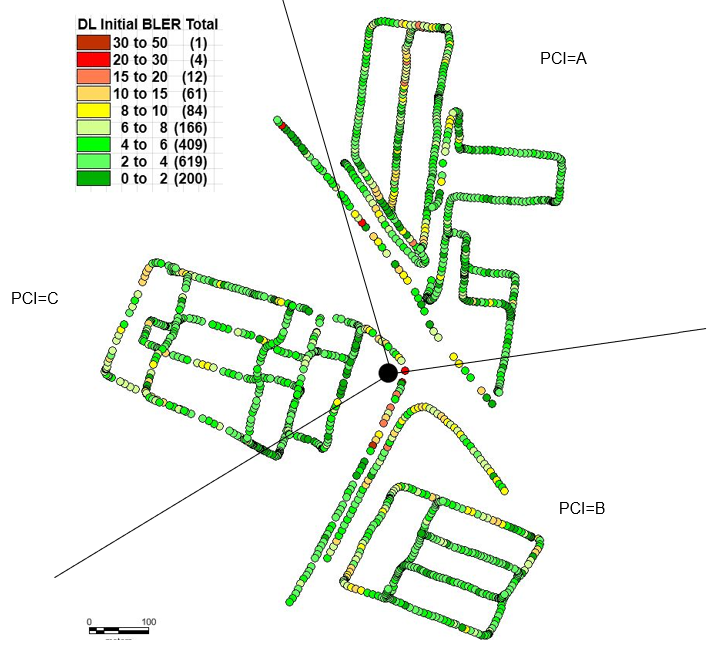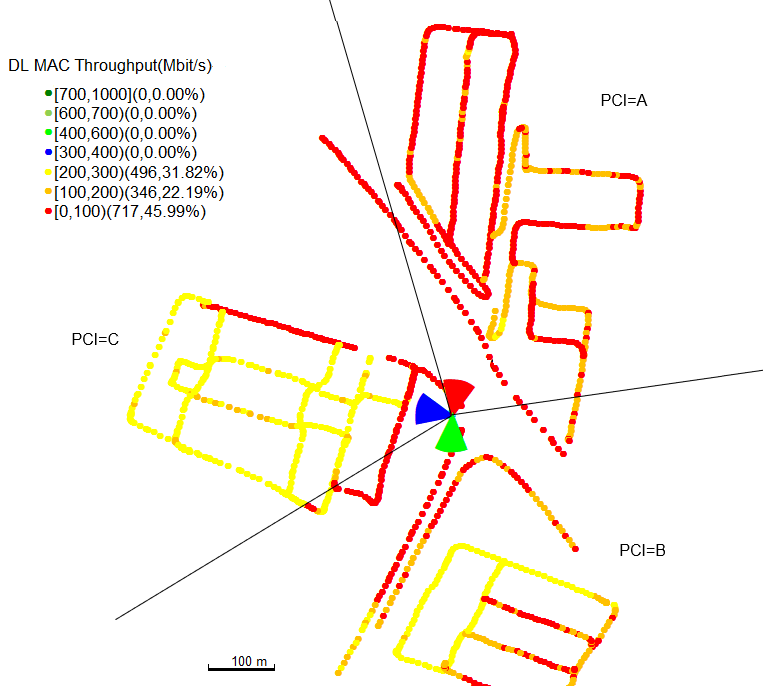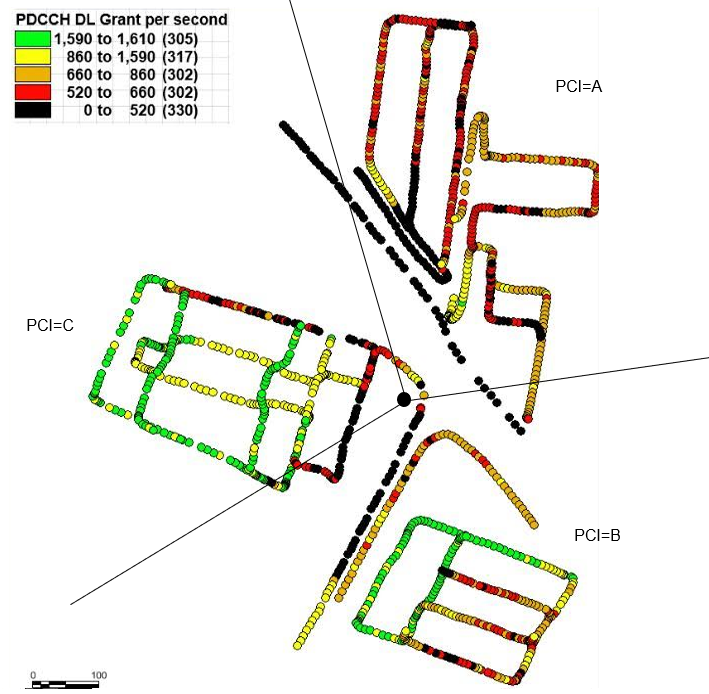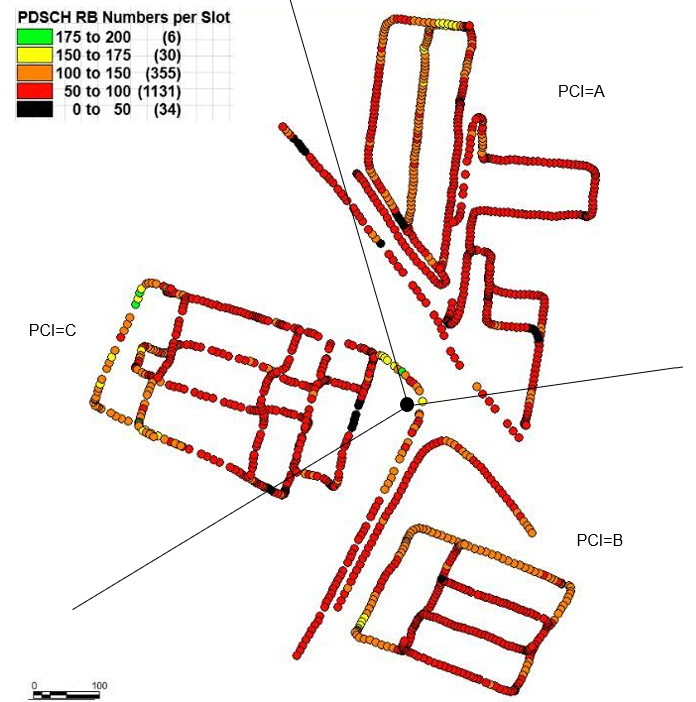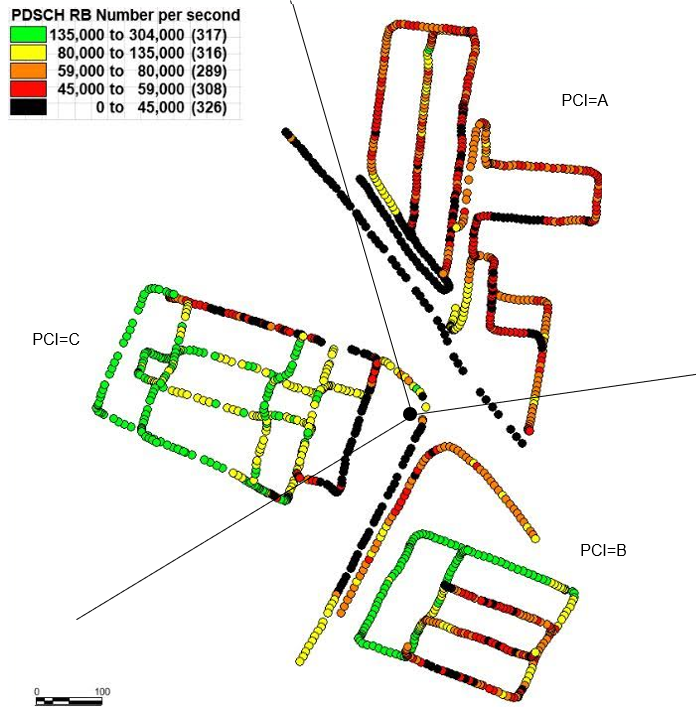|
|
||
|
Coverage TestThe data shared here is from Dan Serbescu (email, LinkedIn). He has been the most active reader and critique (in positive way -:) for my notes. He has been sharing a lot of his own study in linkedIn and I think many of the reader might already seen some of his postings in LinkedIn. All of field data shown here is provided by Dan and comments are from me. If there is anything incurrect, it is my fault. There are many different ways to interpret the same field data and may be many different opinions (even conflicting each other). I will leave it up to you to come up with your own interpretation. Following is the overall test condition. As you see, this is FR1. The gNB is transmitting all SSBs.
Following shows the coverage of each sector and the PCI associated with each sector. It seems one of the sector (PCI B) has a little bit wider coverage than the other two, but I am not sure if this is the intended deployment or just measured like this due to other factors.
Following shows the each SSB associated with the DUT depending on locations within each sector. Even though it is not always obvious, you may identify dominant SSBs depending on angular positions in each sector (In this case, I am using the term sector as a cell).
Following shows the RSRP distribution for each location. You would notice that RSRP for most locations is within the range of -40 ~ -95. I think RSRP is in pretty good range.
Following shows SINR distribution. You would notice that most area is with the range of 5~15. This may be good enough for 16QAM and lower not too high MCS in 64QAM, but definitely not good enough for 256QAM. I think it would be helpful if I can get MCS data for the same test.
Following shows MCS distribution. You would notice that most of the location is using MCS under 20 (this site is using 64Qam MCS table). I think this is reasonable MCS range considering SINR shown above. You would see later that BLER is kept below 10% most of the location.
Following shows BLER distribution. You would notice that most of location shows BLER less than 10 % which is pretty good in live.
Following shows the DL MAC throughput within the tested area. You would notice that PCI A shows lower average throughput than the other two sectors. Would this difference come from scheduling ? or from BLER ? If it is due to scheduling, which scheduling factor (e.g, number of RB, SLIV, MCS, number of scheduled slots within a radio frame etc) would be the determining factor that can explain the MAC throughput difference ? First, it doesn't seem to be due to BLER because it was shown that BLER were similar among every sectors (shown above). So it is likely that the throughput difference would be due to scheduling. Then what would be the major scheduling factor that can explain this throughput difference. At least, it is not MCS since it was shown that MCS distribution is similar across all sectors. Then, it is highly likely that SLIV or Number of RB or number of the scheduled slot is the factor that can explain the throughput difference, but I have no further data to investigate further.
Following shows RI(Rank Index) distributions within the test area and you would notice that RI 3 is reported in most area. This is not the best case considering that the idea rank (the max rank) is 4. I don't know if this is non-ideal overal channel quality issue or if there is some imbalances on UE Rx path. It will be good if I can get RSRP, SNR values for each of UE Rx antenna.
Following shows how many PDSCH are scheduled per second for each sector. You would notice that the number of scheduled PDSCH is much less in PCI A than the other sectors. It implies that the low DL MAC throughput in PCI A is likely to be scheduling differences. But we have to check a couple of other parameters (like number of RBs for each slot and SLIV) for further clarification.
Following shows the number of PDSCH RBs for scheduled slot. It seems the number of RB in in PCI A is just a little bit less than the other sectors, but not as much difference as to explain the DL MAC throughput difference.
Following shows the number of PDSCH RB scheduled per seconds. You see that the number of RBs per second for PCI 564 is much leass than the other two sectors. But in previous plot, you saw that there was not much difference among difference sectors in terms of the number of the scheduled RB per slot. So this difference (i.e, the differneces in terms of number of PDSCH RBs per second) is mainly due to the number of the scheduled slot per second as shown in "PDCCH DL Grant per sec" plot.
YouTube[1] Active Antenna Demo for 5G by Nokia and Mitsubishi (Apr 2015) [1] 5G live test demo: Multipoint Connectivity with Distributed MIMO (May 2015) [2] MediaTek 5G 28Ghz mmWave Technology At #MWC18 (Feb 2018) [3] The Power of Millimeter Wave | Verizon (May 2018) [4] Testing 5G: Pack Your Tent and Cooler | WSJ (Jul 2019) [5] What a REAL 5G experience is actually like! (Jul 2019) [6] Live Qualcomm Massive MIMO 5G Demo (Sep 2019) [7] Qualcomm 5G Massive MIMO Antenna Demo (Sep 2019) [8] mmWave 5G network's "Super Difficult Test" !!! @Qualcomm's San Diego headquarters (Sep 2019) [8] 5G NR Field Measurements Beam Footprints Visualized in 3D (Nov 20109) [9] The PROBLEM with 5G mmW....(Dec 2019) [10] Whats next in Qualcomm 5G leadership (Feb 2020) [11] BIG REVEAL: Watch Qualcomm demo an ultra speedy 5G multi-camera video app (Feb 2020) [12] Qualcomm Press Event: What's Next in 5G? (Full Presentation) (Feb 2020) [13] 5G Mobile mmWave OTA Test Network (Mar 2020) [14] 5G Precise Indoor Positioning (Mar 2020) [15] Fastest 5G mmWave Speeds of 8.5Gbps Achieved Across Multiple Devices (Apr 2020) [16] SpeedTestin' | Verizon 5g MMWAVE | checking all the carriers Verizon vs AT&T vs Sprint vs T-Mobile (Jul 2020) [17] SpeedTestin Verizon UWB & T-Mobile mmwave. Also, all carrier testing in Downtown Los Angeles. (Aug 2020) [18] SpeedTestin Verizon 5g (with new icon) vs AT&T vs T-Mobile and a bit of Sprint (on Tmo) (Sep 2020) [19] Verizon 5G MMWAVE SURPRISE! (to me) | AT&T still killing it | T-Mobile and Sprint Testing as well. (Sep 2020) [20] Testing Pixel 5 on Verizon's mmWave 5G Network! (Oct 2020) [21] iPhone 12 on Telstra 5G - Web browsing & YouTube (end-user experience) (Nov 2020) [22] ATT 5G MMWAVE speed test 2020 iPhone 12 5G San Antonio (Nov 2020) [23] The case for mmWave in 5G networks (Jan 2021) [24] mmWave 5G TCU (Jan 2021) [25] How to buy the Best 4G/5G Cellular Router for you! -- Real data for real decisions. (Jan 2021) [26] T-MOBILE stepping up huge! 1,000+ mbps mmWave bringing real capacity to T-MOBILE 5G! (Feb 2021)
|
||
